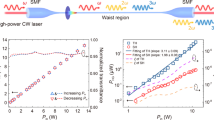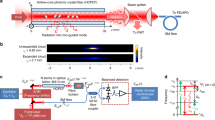Abstract
Tightly confined light enables a variety of applications ranging from nonlinear light management to atomic manipulation. Photonic-crystal fibres (PCFs) can provide strong guidance in very small cores while simultaneously offering long interaction lengths1. However, light confinement in waveguides is usually ultimately limited by diffraction2,3, which tends to spread light away from the waveguiding core, despite its higher refractive index. It was recently demonstrated that such spreading fields can be trapped by a nanometre-scale slot inside a strongly guiding silicon-on-insulator (SOI) waveguide4,5. In this letter we demonstrate the concentration of optical energy within a subwavelength-scale air hole running down the length of a PCF core. The core resembles a submicrometre-diameter tube with a bore diameter of 200 nm or less. The high intensity in an air hole, coupled with long interaction lengths, promises a new class of experiments in light–matter interaction and nonlinear fibre optics.
This is a preview of subscription content, access via your institution
Access options
Subscribe to this journal
Receive 12 print issues and online access
$209.00 per year
only $17.42 per issue
Buy this article
- Purchase on Springer Link
- Instant access to full article PDF
Prices may be subject to local taxes which are calculated during checkout




Similar content being viewed by others
References
Knight, J. C. Photonic crystal fibers. Nature 424, 847–851 (2003).
Foster, M. A., Moll, K. D. & Gaeta, A. L. Optimal waveguide dimensions for nonlinear interactions. Opt. Express 12, 2880–2887 (2004).
Zheltikov, A. M. The physical limit for the waveguide enhancement of nonlinear-optical processes. Opt. Spectrosc. 95, 410–415 (2003).
Xu, Q. F., Almeida, V. R., Panepucci, R. R. & Lipson, M. Experimental demonstration of guiding and confining light in nanometer-size low-refractive-index material. Opt. Lett. 29, 1626–1628 (2004).
Almeida, V. R., Xu, Q. F., Barrios, C. A. & Lipson, M. Guiding and confining light in void nanostructure. Opt. Lett. 29, 1209–1211 (2004).
Baehr-Jones, T., Hochberg, M., Walker, C. & Scherer, A. High-Q optical resonators in silicon-on-insulator-based slot waveguides. Appl. Phys. Lett. 86, 081101 (2005).
Roberts, P. et al. Ultimate low loss of hollow-core photonic crystal fibres. Opt. Express 13, 236–244 (2005).
Benabid, F., Knight, J. C., Antonopoulos, G. & Russell, P. S. J. Stimulated Raman scattering in hydrogen-filled hollow-core photonic crystal fiber. Science 298, 399–402 (2002).
Saitoh, K., Florous, N. & Koshiba, M. Ultra-flattened chromatic dispersion controllability using a defected-core photonic crystal fiber with low confinement losses. Opt. Express 13, 8365–8371 (2005).
Ito, H., Sakaki, K., Nakata, T., Jhe, W. & Ohtsu, M. Optical-potential for atom guidance in a cylindrical-core hollow-fiber. Opt. Commun. 115, 57–64 (1995).
Vahala, K. J. Optical microcavities. Nature 424, 839–845 (2003).
Nazarkin, A., Korn, G., Wittmann, M. & Elsaesser, T. Group-velocity-matched interactions in hollow waveguides: Enhanced high-order Raman scattering by impulsively excited molecular vibrations. Phys. Rev. A. 65, 041802 (2000).
Koshiba, M. & Tsuji, Y. Curvilinear hybrid edge/nodal elements with triangular shape for guided-wave problems. J. Lightwave Technol. 18, 737–743 (2000).
Acknowledgements
The authors would like to acknowledge help from A. George in fabricating the fibres and assistance from A. Frasson and H.E.H. Figueroa in the numerical simulations. G.S.W. and C.M.B.C. acknowledge financial support of the National Council for Scientific and Technological Development (CNPq) and Fundação de Amparo à Pesquisa do Estado de São Paulo (FAPESP). Work at Bath was funded by the UK Engineering and Physical Sciences Research Council.
Author information
Authors and Affiliations
Corresponding author
Ethics declarations
Competing interests
The authors declare no competing financial interests.
Rights and permissions
About this article
Cite this article
Wiederhecker, G., Cordeiro, C., Couny, F. et al. Field enhancement within an optical fibre with a subwavelength air core. Nature Photon 1, 115–118 (2007). https://doi.org/10.1038/nphoton.2006.81
Issue Date:
DOI: https://doi.org/10.1038/nphoton.2006.81
This article is cited by
-
Numerical Demonstration of Photonic Quasi-Crystal Fiber–Surface Plasmonic Resonance Urinary Methanol Sensor
Plasmonics (2023)
-
Design of a Dual Cluster and Dual Array-Based PCF-SPR Biosensor with Ultra-high WS and FOM
Plasmonics (2022)
-
Design and analysis of a QC-SPR-PCF sensor for multipurpose sensing with supremely high FOM
Applied Nanoscience (2022)
-
Numerical Investigation of Side-Polished SPR PCF Sensor for Urine Analysis
Plasmonics (2022)
-
Highly Sensitive U-Shaped Micro-channel Photonic Crystal Fiber–Based Plasmonic Biosensor
Plasmonics (2021)



